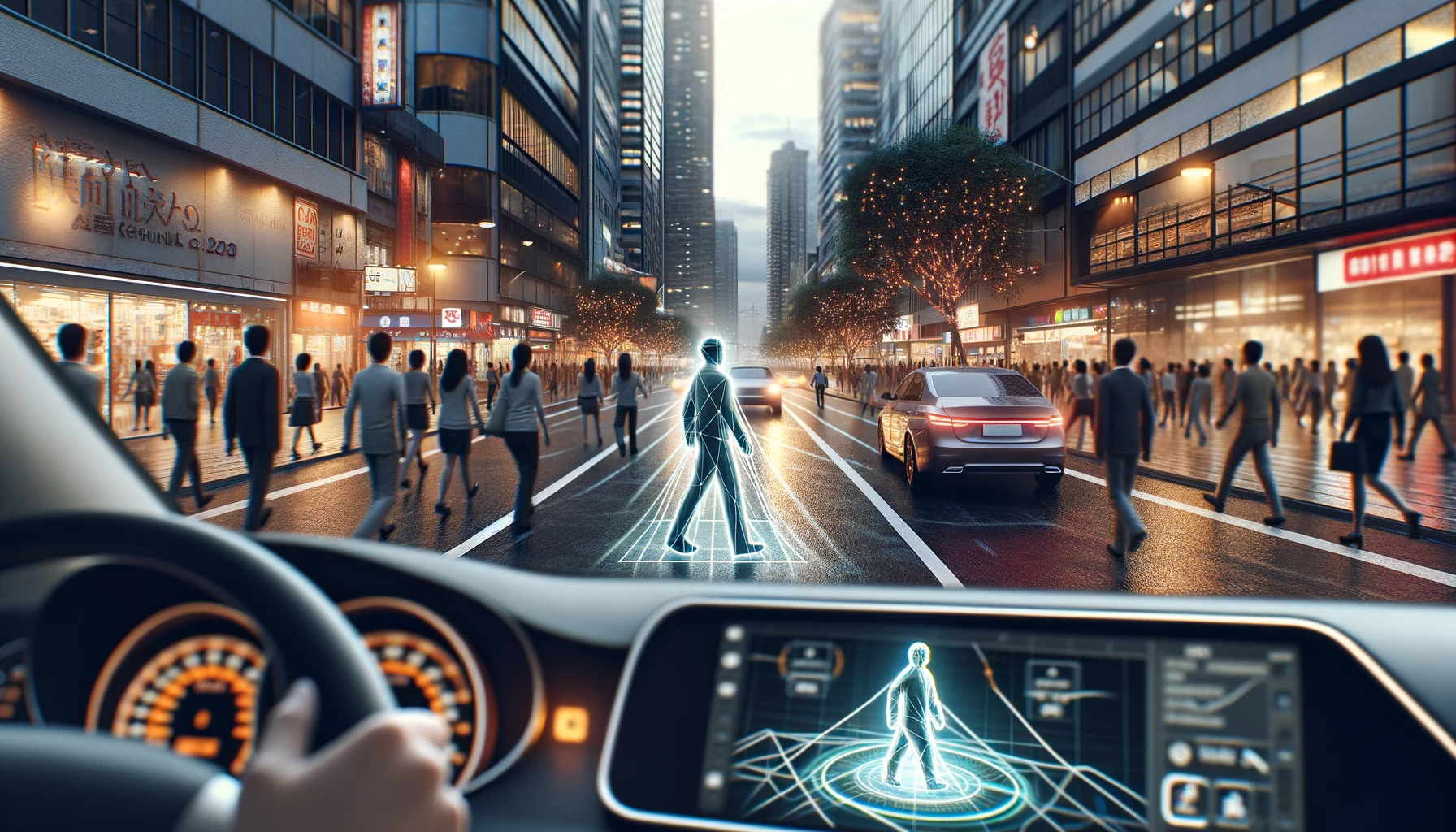A study published in the journal PLoS ONE introduces an advanced pedestrian detection algorithm for autonomous vehicles that integrates significant kernel attention mechanisms into the lightweight You Only Look Once Version Five (YOLOV5) model architecture. As intelligent transportation systems progress toward road safety and efficiency, robust pedestrian detection remains an essential perception requirement. However, real-world issues like occlusion, small targets, and positioning inaccuracies have challenged existing detection models.
 Study: Elevating Pedestrian Safety in Autonomous Vehicles: A Kernel-Attentive Approach. Image credit: Generated using DALL.E.3
Study: Elevating Pedestrian Safety in Autonomous Vehicles: A Kernel-Attentive Approach. Image credit: Generated using DALL.E.3
To address these limitations, the researchers present a novel approach fusing a large kernel attention module, coordinating attention retention, and adaptive loss tuning in a streamlined model. Experiments demonstrate enhanced pedestrian recognition, especially for partially obstructed people, boosting YOLOV5 baseline accuracy. The modifications enhance spatial visual focus and precision while balancing model compactness. This algorithm offers promising capabilities for enabling safer vehicle-pedestrian interaction through robust recognition. As urban autonomous driving further matures, techniques like this could be generalized for additional safety tasks.
Pedestrian Detection Models
Modern pedestrian detection relies predominantly on deep convolutional neural network architectures that leverage automated feature learning. Single-shot approaches like YOLOV5 eliminate expensive region proposal computations, offering high processing speeds that are advantageous for autonomous platforms. However, issues still need to be addressed in handling ambiguous or obscured people familiar with complex urban environments. Attention mechanisms are widely adopted to focus models on vital visual areas while suppressing less relevant regions. Recent variants encode finer spatial relationships and long-range dependencies to boost positioning and inferences for occlusion. The study aimed to build on these attention approaches to enhance the baseline YOLOV5 model for challenging pedestrian scenarios.
The standard YOLOV5 backbone utilizes a focus module for computational efficiency, repeated convolutional blocks, large kernel C3 modules, and space pyramid pooling. This architecture enables multiscale feature learning to detect objects across sizes. The neck combines a feature pyramid network with a path aggregation network for enhanced localization and semantics. Finally, the detection header predicts categories, objectness scores, and bounding boxes across layers. This study chose the compact YOLOV5s version and incorporated attention to further optimize pedestrian analysis amid complex environments while streamlining model size.
Improved Pedestrian Detection Algorithm
The researchers leveraged the public Berkeley Deep Drive 100K (BDD100K) dataset to train and evaluate the enhanced detection algorithm. Containing over 25,000 pedestrian annotations across various driving images, the dataset encompasses diverse environments, weather conditions, and times of day. This urban camera imagery provides essential variability for improving model robustness within realistic autonomous contexts. The team randomly divided the dataset into training and validation sets for experimentation.
The proposed model modifies the baseline YOLOV5s architecture in three ways: integrating extensive kernel attention into its convolutional C3 module, adding lightweight coordinate attention, and utilizing an adaptive loss function. The large kernel attention fusion enables expanded spatial context perception and extended range dependency modeling. Specifically, the 21x21 convolution gets decomposed into cascaded 7x7 dilated and 5x5 convolutions, reducing computations. This large kernel attention (LKA) integration replaces the original C3 bottleneck design to prioritize vital visual information. Further efficiency comes from Ghost convolutions that limit channel parameters.
The neck network sees the addition of a novel coordinate attention-normalization block module. This hybrid technique captures subtle spatial details and channel variations indicative of pedestrian locations against complex backgrounds. Explicitly encoding positions allows focusing on critical local elements.
Finally, positioning performance improves with an alpha Complete Intersection over Union (CIOU) loss function instead of YOLOv5’s CIOU version. This enables tuning the loss gradient scaling factor to better regress bounding boxes. These targeted optimizations enhance feature learning, attention narrowing, and localization to boost pedestrian analysis. The modifications counter inherent ambiguity and positioning imprecision for safe trajectory planning.
Experimental Results
Following training on the diverse BDD100K urban dataset, experiments demonstrated 60.3% pedestrian detection accuracy. This marks a noticeable improvement over the 59.3% baseline YOLOV5s model, resulting primarily from the attention upgrades. The extensive kernel attention and coordinate retention particularly assisted with partially obstructed people by focusing the model on visible components. Additional tests on the PASCAL Visual Object Classes (VOC) dataset further validated versatility beyond just pedestrians.
The improved attention modules increased parameters slightly but ran efficiently at 80 FPS. Overall, the changes enhanced the accuracy versus efficiency tradeoff for embedded applications compared to vanilla YOLOV5s. Test imagery also evidenced upgrades in bounding box precision alignment with obscured people. This precision also proves vital for subsequent tracking and behavior analysis to trigger safe system responses.
Future Outlook
This research presented a promising pedestrian detection system for intelligent vehicles by integrating extensive kernel attention into the lightweight YOLOV5 model. Fusing expanded spatial context perception and coordinate retention assists in narrowing focus on critical occluded target locations. Adaptive loss tuning also proves beneficial for positioning challenges that are pervasive in crowded urban environments. Together, the upgrades help overcome inherent ambiguities and inaccuracies.
As autonomous navigation progresses toward public adoption, robust pedestrian and object detection will remain fundamental for safe trajectory planning and interaction. Techniques like this could generalize to further recognition tasks using optimized neural architectures tailored for embedded automotive computers. Investigating ways to balance accuracy, efficiency, and parameter size will grow increasingly important.
Future work should explore deploying the enhanced algorithm on dedicated vehicle hardware to analyze real-time performance. Testing on larger pedestrian datasets with more variability would assist further. Additional promising areas include integrating transformer architectures to encode spatial relationships and combining lidar point cloud inputs. Progress in model compression, adaptation to adverse weather, and detecting a more comprehensive range of vulnerabilities will also prove critical for fully reliable systems. By addressing these perception challenges, autonomous technology can transition toward broader acceptance.
Journal reference:
- Yin, Y., Zhang, Z., Lin, W., Geng, C., Ran, H., & Zhu, H. (2023). Pedestrian detection algorithm integrating large kernel attention and YOLOV5 lightweight model. PLOS ONE, 18(11), e0294865–e0294865. https://doi.org/10.1371/journal.pone.0294865, https://journals.plos.org/plosone/article?id=10.1371/journal.pone.0294865